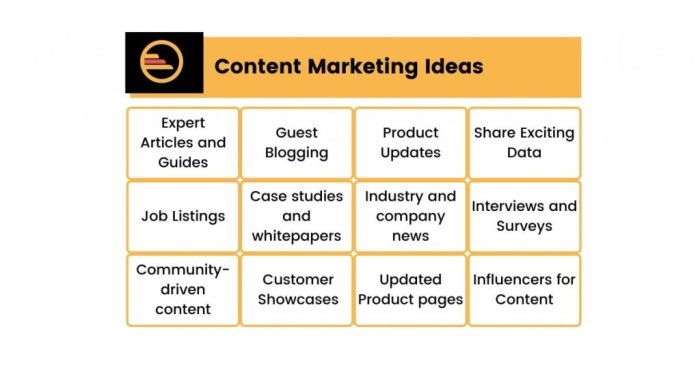Content Marketing Ideas are the lifeblood of any successful campaign, paving the way for innovative strategies that captivate audiences and drive results. Get ready to dive into a world where creativity meets strategy, and where success is measured by the impact of your ideas.
Let’s explore how to turn ideas into action, and how to align your content with your business goals for maximum impact.
Content Marketing Ideas
In the digital age, content marketing has become a crucial strategy for businesses looking to engage with their target audience in a meaningful way. Successful content marketing campaigns not only attract customers but also build brand loyalty and drive sales. Let’s dive into some examples of effective content marketing strategies and how you can generate creative ideas to align with your business goals.
Successful Content Marketing Campaigns
- Red Bull’s Stratos Jump: Red Bull’s sponsorship of Felix Baumgartner’s record-breaking freefall from the edge of space captivated audiences worldwide, showcasing the brand’s “gives you wings” slogan.
- Dove’s Real Beauty Campaign: Dove’s campaign challenging beauty stereotypes and promoting self-acceptance resonated with consumers, sparking conversations and boosting brand reputation.
- Airbnb’s Experiences: Airbnb’s content highlighting unique travel experiences personalized to individual interests helped differentiate the brand and attract new customers.
Tips for Generating Creative Content Marketing Ideas
- Understand Your Audience: Conduct research to identify your target audience’s preferences, behaviors, and pain points to tailor content that resonates with them.
- Brainstorm Collaboratively: Encourage cross-departmental collaboration to leverage diverse perspectives and generate innovative content ideas.
- Stay Updated: Keep abreast of industry trends, competitor strategies, and emerging technologies to inspire fresh content concepts.
Importance of Aligning Content Marketing Ideas with Business Goals
Aligning content marketing ideas with business goals is essential for driving results and maximizing ROI. By setting clear objectives and ensuring that content strategies support these goals, businesses can create cohesive campaigns that deliver measurable outcomes. Whether the goal is to increase brand awareness, generate leads, or boost sales, strategic alignment ensures that every piece of content contributes to the overall success of the business.
Types of Content: Content Marketing Ideas

When it comes to content marketing, there are various types of content that can be utilized to engage with the audience and drive results. From written content to visual content and user-generated content, each type has its own unique benefits and effectiveness.
Written Content
Written content includes blog posts, articles, case studies, whitepapers, and social media posts. It is a powerful tool for conveying detailed information, building credibility, and improving . Written content allows for in-depth explanations and storytelling, which can resonate with the audience on a deeper level.
Visual Content
Visual content, such as images, infographics, videos, and memes, is highly engaging and easily shareable. It can quickly capture the audience’s attention and convey messages in a more digestible format. Visual content is effective in increasing brand awareness, driving traffic, and enhancing user experience on websites and social media platforms.
User-Generated Content
User-generated content refers to content created by customers, fans, or followers of a brand. This type of content includes reviews, testimonials, social media posts, and user-generated videos. User-generated content adds authenticity and social proof to marketing efforts, as it showcases real experiences and opinions from actual users. It helps in building trust, fostering community engagement, and expanding reach through word-of-mouth marketing.
Content Distribution

When it comes to distributing content, there are various channels that you can utilize to reach your target audience. Whether it’s through social media, email newsletters, blogs, or even podcasts, each platform offers a unique way to connect with your audience and share valuable information.
Various Channels for Distributing Content, Content Marketing Ideas
- Social Media: Platforms like Instagram, Facebook, Twitter, and LinkedIn provide a great way to share your content and engage with your followers.
- Email Newsletters: Sending out regular newsletters with curated content can help you stay connected with your audience and drive traffic to your website.
- Blogs: Creating engaging blog posts on your website can help improve your and establish your brand as a thought leader in your industry.
- Podcasts: Recording podcasts allows you to share valuable insights and reach a new audience through audio content.
Repurposing Content for Different Platforms
Repurposing content involves taking existing content and modifying it to fit different platforms. For example, you can turn a blog post into a social media graphic, a podcast episode into a video series, or an email newsletter into a blog post. This allows you to maximize the reach of your content and engage with your audience in different ways.
Significance of Timing in Content Distribution
Timing is crucial when it comes to content distribution. Posting at the right time can increase visibility and engagement with your content. Consider factors like your audience’s time zone, peak activity hours on different platforms, and trending topics to ensure your content reaches the right people at the right time.
Measuring Success
In the world of content marketing, it’s crucial to measure the success of your campaigns to understand what’s working and what needs improvement. By analyzing key metrics and using A/B testing, you can optimize your strategies for maximum impact.
Key Metrics for Measuring Success
- Website Traffic: Monitor the number of visitors to your site and track where they are coming from to gauge the effectiveness of your content.
- Engagement Metrics: Look at metrics like bounce rate, time on page, and social shares to measure how engaged your audience is with your content.
- Conversion Rate: Measure the percentage of visitors who take the desired action, such as signing up for a newsletter or making a purchase, to assess the effectiveness of your content in driving conversions.
- ROI: Calculate the return on investment to determine if your content marketing efforts are generating a positive impact on your bottom line.
Analyzing Data to Optimize Content Marketing Strategies
It’s essential to use data-driven insights to make informed decisions about your content marketing strategies. By analyzing metrics regularly, you can identify trends, patterns, and areas for improvement.
| Tip 1: | Utilize analytics tools to track and measure key metrics consistently. |
|---|---|
| Tip 2: | Segment your audience to understand their preferences and tailor your content accordingly. |
| Tip 3: | Experiment with different types of content to see what resonates best with your audience. |
Importance of A/B Testing
- A/B testing allows you to compare two versions of a piece of content to see which performs better in terms of engagement and conversions.
- By testing elements like headlines, images, and calls-to-action, you can identify what drives the most positive results and make data-backed decisions for future content.
- Regular A/B testing is essential for optimizing your content marketing strategies and ensuring continuous improvement.
